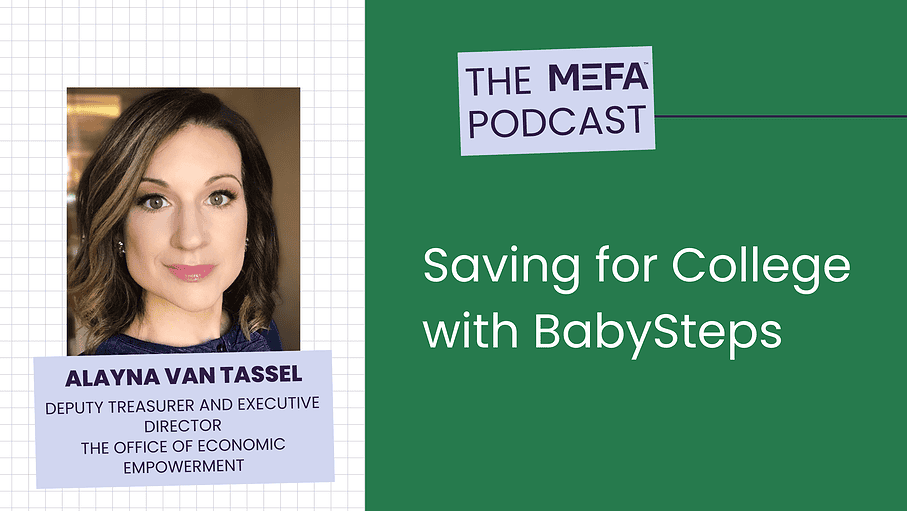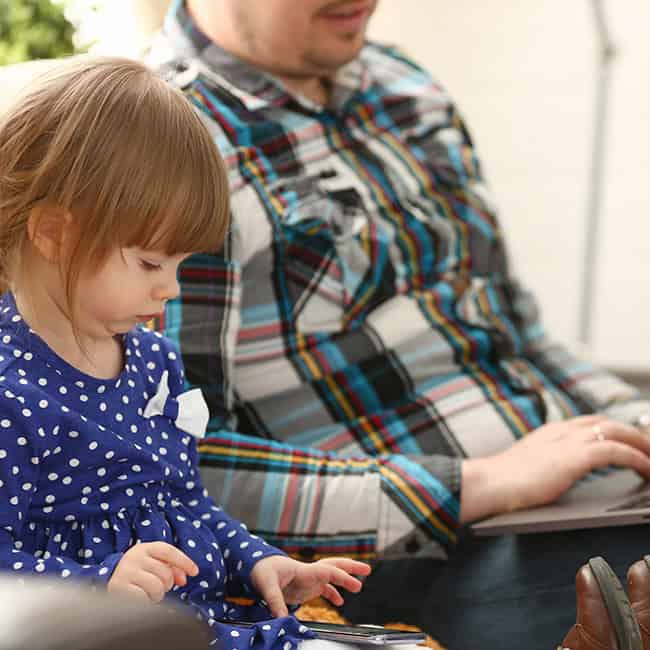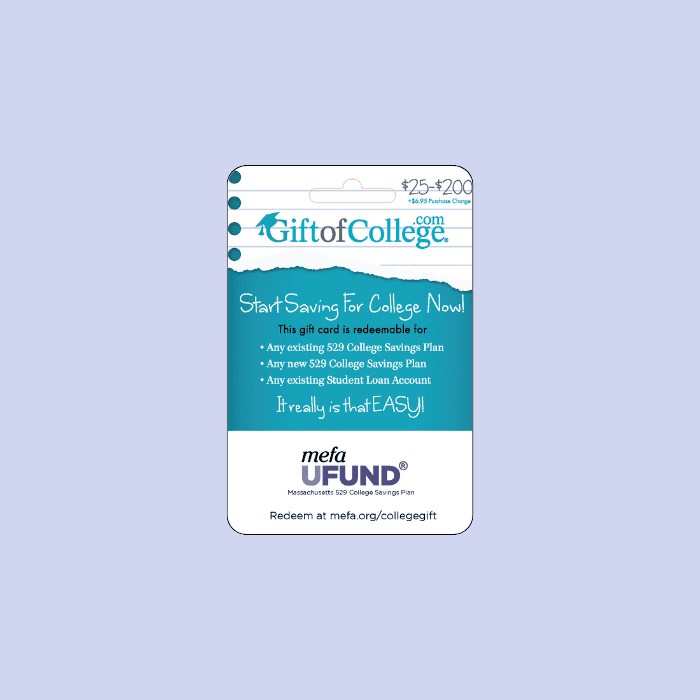Resources Mentioned in this Episode
Jonathan Hughes: Hi, everyone. Welcome back to the MEFA podcast. My name is Jonathan Hughes and I am the host of the podcast and I am joined as always, and I think we can say it at this point, always, by Julie Shields-Rutyna. Hi, Julie.
Julie Shields-Rutyna: Hello, happy to be here. Happy to always be here.
Jonathan Hughes: And we’re going to be talking to the head of the Massachusetts Office of Economic Empowerment, Deputy Treasurer, Alayna Van Tassel.
She’s going to talk about the BabySteps program, about her office, and the first year of the BabySteps program. So, uh, this is the program. Once again, it seeds $50 into your U.Fund account for every baby born or adopted in Massachusetts. They have one year to claim that. So stay tuned for that.
We’re so excited about the program and I hope you are, but before we do all that, of course, we have some things to talk about. It’s our first show of 2021, which sounds amazing. It feels like 2021s already been going on for a long time. And there are already big developments on the horizon, uh, for the future of college admissions. So big things. And Julie, some big news you can take us through and talk about big changes to the SAT.
Julie Shields-Rutyna: Yes. So this is, this is what we learned this week. There are going to be some big changes and not surprising in a way, right. John, as you and I have talked about on this program, that it seems like COVID-19, um, brought to light some changes maybe that needed to happen anyway, and it just maybe sped things up.
So, um, so I guess we’re not so surprised to see this, but it is big, big news on the admissions front.
Jonathan Hughes: Yeah. Changes in the SAT are always, I think, big news to everybody. And there were three parts. So this particular announcement that they made, uh, and the first one is if you want to discuss there, they’re talking about discontinuing SAT subject tests.
So a lot of people probably weren’t aware that there was such a thing. So if you wanted to talk about what those are and what that means, that they’re being discontinued, that would be great.
Julie Shields-Rutyna: Yes. So SAT subject tests are a different test than the actual SAT. Uh, but some colleges required students to do those subject tests to show their knowledge in certain subjects.
And over time though, fewer and fewer colleges were requiring those SAT subject tests. So I think the College Board® finally feels comfortable not using those for students anyway. And instead, one of the reasons they feel really comfortable discontinuing the SAT subject tests is the advanced placement®. The AP® program and the AP courses that the College Board has that many, many high school students have as offerings in their high school are a terrific way to show their skills and knowledge in specific areas in specific subjects. And the College Board really feels like those AP courses are in such a wide range of high schools and that they are reaching a very, very wide demographic of students.
So students have the ability to use that as a way to show their success in different subjects. So that they feel like that’s even a better way to cover that.
Jonathan Hughes: Seems to make sense. Yeah. And then the second piece is I think, you know, almost as big or bigger, is that they’re actually discontinuing the optional SAT essay.
Julie Shields-Rutyna: Yes. And so that also had been a requirement that was really required by fewer and fewer schools. And so while students could sign up to add that onto their SAT, the SAT is already a very long test. And so I think they were happy if they weren’t required to do it, to not do that optional piece. And again, fewer and fewer colleges were requiring it.
And the College Board again, feels that the reading and writing section of the SAT more than covers those topics and allows a student to show mastery in those areas.
Jonathan Hughes: Hmm. And the third change has to do again, it’s a pandemic sort of accelerated development I guess, and that is to develop a more flexible SAT.
One that’s able to be done digitally and delivered and practiced that way. So I don’t know if you could talk about that a little bit.
Julie Shields-Rutyna: Yeah. And you know, really for that change, which is the big news, that one, especially that the SAT itself is going to be changed. We don’t know much more. We just know that it’s going to be more flexible.
And as you said, be able to be delivered digitally, which we know will allow for it to be. Students should take it if we’re in an environment as we are right now. And so the only other thing I will add is the College Board has announced they’re going to work very closely with their K through 12 members and their higher education members to collect a lot of information, so that they can have a test that seems to work for everyone.
Jonathan Hughes: Yeah, that’s great. I mean, it’s definitely, you see that a lot of colleges are going to test optional, but they’re not requiring standardized tests anymore. So I think it’s a good development for the SAT to be able to stay a little more innovative as they say, and nimble and be able to be used by more students. As they point out that, you know, there is a demand from students, as they say in their statement, to take the SAT as a way to demonstrate their strength.
And I think it’s great that they’re sort of doing this, that those students can continue to do that. Now, of course, we’re going to head on over to the MEFA mailbag. And these are questions that folks have been emailing us or calling us up with over the past few weeks, things that are on the minds of parents and students right now.
Remember if you have any questions you can contact us by emailing us ag [email protected] or you can call us. Our first question comes to us from Abigail, speaking of college admissions. She references a webinar that Julie presented on college admissions that drew hundreds and hundreds of people as Julie’s webinars always seem to do.
And she writes, thank you so much for hosting the webinar yesterday, was very helpful. As my oldest is a junior this year, which is when you kind of want to start the admissions process, the search, and we are entering uncharted territory. But you were discussing putting our college interests into three categories, probable, target, and reach.
These are the schools that you’re applying to. Your probable schools, which you are likely to be admitted to, your target schools, which are 50/50, and the reach, which are, sort of, you know, you hope you get in, but you’re not sure. So she continues to write, I had a question that I thought of later. My daughter has a high GPA of 3.85, but tested low 1110 on her PSATs.
When deciding if a college is probable or target, should I be following the school’s GPA, suggestion or SAT range? I’ve noticed my daughter has the GPA for many colleges, but it is low on what they call the acceptable SAT score. Any thoughts from MEFA would be greatly appreciated. So Julie, we were talking about this. This is a really complicated question.
Julie Shields-Rutyna: Yes. Great. No, sure. I guess what I would say is, I’ll say a couple of things. So first of all, it’s not an exact science, but we get this question a lot where people, we tell people, we want your student to be a good academic fit for the college. And people always say, well, how can I find that out?
And you know, we’ll say be in touch with the college or on the website and look at it. What is the GPA and the SAT scores of their current students. And, uh, but you know, those are two factors that are considered among others in the admissions process. Um, so most colleges don’t have an exact science with that, but it’s good to have a good understanding of oh, okay, my daughter’s GPA seems to be in line with the GPA of many of the students at that college. And likewise, my daughters SAT score seems to be in line with the SAT score of the current students if that’s required. Now, you mentioned this already. Many colleges don’t require an SAT.
So that might not be even a factor in some of those cases, but if it is, I guess it’s kind of a combination. And I guess she would want to see in general that the GPA SAT scores were somewhat in line with those of the students currently at the institution. But another piece is that PSAT is not the SAT.
And so PSAT is a practice. And it’s a great thing because what happens is the student takes that PSAT, gets a score back. The score is less important than all of the detailed information. So sit with your students, go through the questions that you know were wrong. Figure out what the right answer is on those and how to learn those concepts that might’ve been taken into consideration in those questions.
And then you can use the free SAT prep through Khan Academy and the College Board, and really practice then on those questions and answers that you need practice on. So that when you do eventually take the SAT, your score, they very well go up. Preparing for the SAT and the ACT are really all about practice, taking some full length things, exams, and again, practicing those concepts.
So there’s a lot that can be done between now and then. And then yes, just get a good sense from the college of what the current student body looks like.
Jonathan Hughes: Yeah. And if it’s any consolation, your PSAT score was higher than my PSAT score. So our next question comes to us from Carol and she writes, we currently have a student loan for spring of 2021.
That’s this current academic semester. When should we apply for the fall semester? Would it be considered a new loan or an addition to my current loan? And I guess I’ll take this one, if you don’t mind. And say that we’re starting to get some of these calls already for people who want to know how they can secure funding for next semester.
So it’s a little early at this point to do that. If you have a loan for right now and you want to secure funding for next semester. Even if you don’t have a loan for right now, and you’re looking for funding for next academic year, what you want to do, especially if you haven’t gotten your financial aid offer from colleges yet, is wait until that happens.
That’s typically happens around March or maybe early April, at which point you’ll know how much you need to borrow, right. For sure how much you might need to finance. So early spring, maybe the summers, when typically most folks apply for the next academic year. Now, if you have a loan already and you’re looking for funding for the next academic year, it is going to have to be a separate loan.
So you can’t add on to an existing loan for mutual a loan, because it’s a different academic year. And so colleges sort of take these things on a semester by semester basis or a year by year basis. And so there is that dividing line between academic years. So between this current 2021 year and next year is 21, 22 academic year, they would have to be separate loans.
Um, so we have a loan now. Great. But if you want funding for the fall, it’s going to have to be a separate loan. And you’re going to look to do that somewhere around spring time or possibly summer. So that about does it for the mailbag. Again, remember if you have any questions, you can contact us at [email protected] or call us, social on Facebook, Twitter @mefatweets, et cetera.
Now we’re going to go to my previously recorded conversation with Alayna Van Tassel about the BabySteps program one year anniversary, one year birthday. However you want to put it. So please make sure to listen to that and we’ll see you afterwards.
Alayna Van Tassel is the Deputy Treasurer and Executive Director of the Massachusetts Office of Economic Empowerment. MEFA has partnered with the Office of Economic Empowerment, Alayna, and Treasurer Goldberg in the development of the BabySteps program, which utilizes MEFA U.Fund 529 plans to create the first statewide universal college savings program in Massachusetts.
That program was formally launched on January 1st, 2020. So just about a year ago and here to mark the first year of the program, I’m very happy to be joined by Alayna Van Tassel. Hello, Alayna.
Alayna Van Tassel: Hi, Jonathan. So great to see you.
Jonathan Hughes: Yeah. Nice to see you too. Before we talk about the BabySteps program in particular, can you tell me and anybody who’s listening about your office, the Office of Economic Empowerment, and how this program fits in with the office and the mission of that office?
Alayna Van Tassel: Absolutely. Jonathan, I think that’s really important to understand the mission of OEE in the treasurer’s office, just to give you some background.
So Treasurer Goldberg took office in January of 2015, and when she took office and when she was running for Treasurer, she really had a vision. She understood the importance of helping people to have access to the tools and resources that they needed to make informed financial decisions throughout their lives. And as the state treasurer and as the CFO of the States, she really felt that she had not only the ability, but more importantly, the responsibility to make sure that she was able to provide those tools to all Massachusetts residents.
That’s why she really created the Office of Economic Empowerment. Financial education has always historically lived in the Massachusetts Treasurer’s Office. That’s not just the case in Massachusetts, but also nationally, as well. Treasure Goldberg, for the past year in 2020, actually served as the president of the national association of state treasurers.
And she’s been actively involved in their financial agent education committee as have I, so it really is something that’s done nationally. But Treasure Goldberg wants to really go beyond, not just financial education, but the overall umbrella of economic empowerment. So under our office of course is financial education, but also, gender and racial equality, as well as college affordability and promoting STEM education. When I say gender and race equality, closing the gender and race gap.
Jonathan Hughes: Well, I know that we were really excited to hear about the program, obviously, and it began with those two pilot programs that we worked on together, to lead up to the BabySteps launch. But you know, we’re going to get to that first year of BabySteps. Before we do, I wonder if you could just explain to everyone listening what exactly is the BabySteps program?
Alayna Van Tassel: Sure. BabySteps program is a seeded college savings account program. It’s Massachusetts first seeded college savings account program. As you mentioned at the beginning of the podcast, this program launched of January 1st of 2020. And basically starting this past January, all babies born or adopted here in Massachusetts have access to $50 into a 529 account through MEFA. When they open up a 529 plan, families have until the child’s first birthday or until the first anniversary of their adoption of the child’s adoption order to access the $50when they have the child. Well, I’m in the hospital. There is the parent worksheet for getting the burst of the gift form right on that worksheet.
Families can check the box right on there to indicate interest in the program. That information is then sent to the Treasurer’s office into MEFA and then we’ll contact the families to help them get started in helping them to open up the 529 account. It really makes it very easy to help families start saving early.
Jonathan Hughes: And, you know, you mentioned this was one of the very first things that the treasurer initiated when she was inaugurated. And then we know, you explained very well how it fits into the mission of the office overall. But tell me from your perspective why this was all important to the treasurer to get this done into your office as one of the very first things that was done.
Alayna Van Tassel: Sure. You know, one of the reasons why college savings was really important to Treasure Goldberg is studies clearly indicate that children in a college savings account are not just more likely to go to college, but they’re more likely to graduate.
And with a college degree. Studies also show that that means higher paying jobs, which is good for the overall state’s economy. And as the state treasurer, and as a CFO for the Commonwealth, it really is her job to make sure she’s doing everything that she can to help promote the state’s economic growth.
And she really feels like a college savings and helping families start to save as early as possible in this case, you know, right at birth. And that to make it as easy as possible, just so that a savings can accrue over time. So the families are then ready for either college or technical training.
And that’s part of the reason why the 529 account was the vehicle that we chose to use for BabySteps in for our CSA program. Um, is that it can be used for not just an undergraduate degree or an associates degree, but also for technical training as well. You know, for some students, that is what they’re going to choose.
And it’s also flexible too, that it can be used for also fees and other associated costs with higher education.
Jonathan Hughes: Yeah, I think that’s a great point that you brought up. I mean, we’re so focused a lot of times on college, especially in Massachusetts, but I think it’s great to keep mentioning that these accounts 529 accounts don’t have to be used for college.
They can be used for career training or certificate programs. Just to point out that there are other paths. It’s not that everybody has to take the same path to what they want to achieve in life. So MEFA has offered the U.Fund since 1999. And we’ve worked with Fidelity obviously to promote that program since that time.
So we know you mentioned, you know, getting that account set up as early as possible. We know how important that is. A lot of people sort of know that they should be saving for college or know that it’s important to save for college, but actually getting them to open an account is the really the biggest hurdle.
So when it comes to BabySteps in particular, can you tell me what steps were taken to make sure that the program is accessible? So it’s easy to open and then a broader perspective why it’s important to promote college savings to young families and also to the families that we’re trying to reach most with this particular program. That is the families who may not have opened up a 529 plan to begin with, unless this program was around.
Alayna Van Tassel: That’s a great question, Jonathan, I should tell you, BabySteps was actually created afterwards three year pilot program. We ran a pilot program in Worcester, Massachusetts in Munson, Massachusetts.
This program was actually done at the kindergarten level. When we initially envisioned the program, we thought it would be something that we would be able to combine with a kindergarten enrollment. The families would be able to start the process of opening up the 529 account when they enroll their children in school.
Um, we quickly realized working with kindergarteners was going to be at that level was actually going to be challenging due to privacy concerns. We had to get parental consent in order for the school systems to verify the children’s enrollment in both districts. And let me tell you, I have a young child who school age, and we had paper consent forms the first year of the pilot. They had to get from the backpack into the hands of the school administrators. And a lot of times that did not happen. And as the parent of a young child, I completely understand why.
And we were able to make some changes and make the consent electronic, but because we have a district controlled schools is some here in Massachusetts, we were not able to make a streamlined enrollment process that we really envisioned. And we, you know, when we were working in these two communities, both Worcester and Monson, and we were always, the goal was always to create a statewide program.
So we’re always looking at our ultimate goal is how can we make this work? Not just in these two communities, but for every community in Massachusetts. And we realized that we wanted to, that the schools may not be the best place to be doing it. Schools are so busy right now.
We also, when we were doing this program, we talked to families that were enrolling in the program. We also talked to families that chose not to enroll in the pilot. And one of the key pieces of feedback that we actually heard from some families that chose not to open up account, was they already had a college savings account for their child.
And that’s great. So that means that some families were already starting to save much earlier than kindergarten. So we really, you know, took that information and looked at the best approach. We’re rolling this program out statewide, which is why after the pilot program, we really made the decision.
We made the very thoughtful and conscious decision to move the program from kindergarten to birth. Being able to move it to birth, we were able to utilize the parent worksheet that is used at all hospitals across Massachusetts that have maternity units and that all families have to use in order to get a birth certificate here in Massachusetts, by adding the check the box.
And I should, I should mention that, you know, we came into the department of public health and we went to the secretary of health and human services to talk to them about our vision and our goal. And they couldn’t have been more supportive and understanding and work with us to get this done or to meet our deadline of January, 2020.
So by adding it onto the form that every parent has to fill out when at the time of birth and where to get a birth certificate, really streamlined the process, made it as easy as possible for all parents to fill out. And then, you know, families can now start at birth, which is, you know, obviously sooner than kindergarten.
So if families can start saving at an earlier age, the savings and the interest will accrue and it gives me more opportunity to, put funds away for the ultimate goal of higher education.
Jonathan Hughes: Yeah, thanks. And I think you’ve done a great job as well making sure that there’s access for non-English speakers, online access for that, where you have, translations for, I think it’s the 10 languages on the BabySteps website. It’s babystepssavingsplan.org. Is that correct?
Alayna Van Tassel: It is, and it’s babystepssavingsplan.org. And you know, this was really something that was really important to us. And I should tell you, you know, like I said, we did a pilot in Western Mass, achieved it in everything we did, even in that pilot was translated into eight different languages.
Cause that we really want to make sure that, you know, people can access information. And the languages that are spoken at home and, you know, with BabySteps, we have, the BabySteps savings plan website, babystepssavingsplan.org. And I mentioned it again and, our materials are available in the top 10 languages spoken in Massachusetts, really want to make sure that families can get the information in their native languages.
Jonathan Hughes: And one more thing before we move on to the numbers. I just want to mention, cause you did mention the pilot program, and having things translated into eight different languages. And I mentioned that, that we, you know, I worked on the pilot program with you. And so we went out to different communities throughout the state.
And, you know, for example, I’m thinking about Lowell and the, the huge population that’s there, and having events as well as it as an English. And that’s big, not just the translation, but also to the partnerships that we have with local communities and local organizations.
And I’m wondering if you could talk for just a minute about how those partnerships work and how important they are.
Alayna Van Tassel: Sure. That was one of the key lessons that we learned working in both Western Mass and, you know, families really need to hear about this program multiple times, but not just from, you know, MEFA or the state treasurer’s office.
They also need to hear about it from trusted sources, you know, organizations that they’re familiar with. People that they already know, whether it’s faith based organizations, nonprofits, those have been tremendously helpful and really key partners as helping to educate families about the importance of saving for higher education.
And this was true, not just for the pilot, but really for BabySteps as well too. The beginning of last year, we were holding enrollment training sessions for some of our key partners throughout the state. We initially started them in person, so that they can then working with clients, they can enroll them right there into the 529 plan.
I know Jonathan, you really been so fabulous in these enrollment trainings, helping our partners, learning how to open up a 529 account. Now we’ve since moved these enrollment trainings online due to the pandemic. But we really hit, you know, every region of Massachusetts and we plan on continuing this into 2021.
And you know, any organization that is working with young families, expecting families, we’re happy to work with you, to work with your staff, so that you can learn how to open up a 529 account. Educate around the clients that you’re working with and the families you’re working with about the importance of starting to save early and the benefits of saving early.
Jonathan Hughes: All right now. So as you mentioned a few times, the program launched on January 1st, 2020. And I did have this in my mind ever since we started the podcast, that one of the very first things that I thought of maybe the first or second idea I had was to have you on in January and talk about the first year of the BabySteps program. And how well we did and the progress.
And one of the biggest questions that we have, and there are other programs like this in various cities and various states. And one of the big questions in the field is how do we define success? We do have some information that we can go over from a yearly perspective. So what are the factors that we’re looking forward to judge, and how has the program performed in terms of hopes and expectations?
Alayna Van Tassel: Sure. First, you know, I should really say, you know, you were planning this in last January and last January seems like sometimes a lifetime ago. You know, we, you know, we launched the program. We knew the first year was going to be challenging. We certainly could not have predicted the types of challenges that we faced.
I should mention that when we launched the program, we were planning a large publicity tour with Treasurer Goldberg. You know, her plan was to visit hospitals throughout the state to talk to the hospital staff and really raise awareness about the BabySteps program. Before the beginning of March, we were able to visit UMass Memorial in Worcester, as well as Baystate Hospital in Springfield.
Due to COVID-19, you know, all hospital visits were not able to happen. All our in-person programming moved online. So you know, a lot’s changed since January 1st, 2020, but, you know, in terms of, you know, what has happened this first year, what is it, what is, you know, what we’ve seen is families are still checking the box.
We’re right around 47% of families checking the box and hospitals, which did not really change much during the year, which we think, you know, considering the year and considering, you know, that we were not able to have some hospital visits that we anticipated. We think that really says a lot that families are interested in the program.
But we also know families are opening up accounts. Um, you know, right now a little over 4,000 accounts, have funded. And I do say funded because we don’t have to file numbers right now for, um, opened accounts in 2020, because there is a 30 day waiting period. So it’d be, we will be funding accounts, um, from 2020 into 2021.
You know, and, you know, but BabySteps isn’t just opening up the accounts. You know, the goals for the program really go beyond that. Many of the goals are long-term that we’re not going to be able to see immediately, but, you know, the primary goals of the program are increasing the percentage of families saving for higher education here in Massachusetts.
Delivering high quality financial education programming for families in boosting post-secondary enrollment and graduation rates here in Massachusetts. Now that last one, it was certainly, won’t see, you know, for quite some time as, until these children, um, you know, graduate from high school and make decisions about higher education.
But I think it’s really important to note that, you know, we talk about savings what type of growing savings, but what we’d like to say in the treasurer’s office, I know they say this to my friends at me for all the time with BabySteps. We’re not just growing savings, we’re growing aspiration. And that’s why, you know, that boosting post-secondary enrollment rates is really so important.
But increasing the percentage of children’s savings for higher education in Massachusetts. We’ll be able to get a better sense of that in the coming months. We can compare, you know, enrollment rates of 529 accounts before BabySteps and after BabySteps. We have a Director of Program Evaluation who, you know, tells me every, you know, when I ask her, how are we doing? How are we doing?
She goes, Oh, it’s too soon. It’s too soon. Uh, we, you know, it, it is the first year of the program. Our goal was really to see around 10%, take rate for the first year. And again, we don’t have the final numbers yet, so it’s hard to say, but you know, I think what we’ll do is we’ll get a baseline from the first year and then we’ll, our goal will be to, you know, increase that all the time.
I’ll never forget when we were starting to create BabySteps. We were talking to our friends in other states who have similar programs and one day, not on my conference table in my office, I had materials from another state on my desk and another staff member came in and saw that. And they had a friend in that state who was expecting a child and they took a picture of it and texted her immediately, that friend in that other state texted back.
And I should say it was a much more established program and the person goes, oh, yes, of course I know about that program. Yes. I’m opening up an account. Why wouldn’t I. That is our goal. I think, you know, with time as families start to really hear about this program is more families talk to each other about opening up a BabySteps account in the child’s first year.
You know, I think that, you know, we really want at union, you have a child, you adopt a child. You open up your 529 account. I think that’s really what our goal will be. And it’s kind of, it will take some time, but I think that as we continue to work together, the treasurer’s office and NMEFA and Fidelity, as well as all of our tremendous partners across the state, that I should say really, even in these very difficult times have, you know, been so helpful.
You know, I think it will happen. It’s just, you know, it, this isn’t to two day delivery, it’s gonna take some time. But I also want to really just say, even during these times, when the hospitals have been at the front lines of this horrific pandemic, they have been nothing but supportive of this program from day one. And it continued to be, so I just want to say thank you to all the public health professionals that have been out there every single day, and everything that they have been doing right now to keep us all safe.
Jonathan Hughes: Yeah, I think that’s great that you mentioned that and, I can just tell you from MEFA’s perspective, from my perspective, at least, you know, I know that there’s awareness for the program because folks call up.
They called MEFA about the BabySteps program. I think the biggest question that we get is from people who did check the box and think that they have an account now. But, as you mentioned checking the box, not opening the account, right? So you had to go and actually do open that U.Fund account. And then automatically you don’t even, even if you don’t check the box, if you’re eligible for the account, if you’re eligible for the seed money, the application or Fidelity, who services the accounts will know that.
And your funds will be seeded in automatically. Now, one other question that we get that I thought you might want to answer very quickly. It’s a common question. Is can grandparents open up a, um, a 529 account and get a U.Fund account and get the BabySteps seed money?
Alayna Van Tassel: Yes, absolutely. And I think you just mentioned this, I think that’s really important.
Even if families don’t check the box in the hospital, even if, you know, a grandparent who wants to open up the account for the child, or maybe it’s an aunt or uncle, or, you know, a godparent or another close family member, they certainly can do that. They just need the social security number or the tax ID number.
Like you just mentioned, if they go to the U.Fund website and they open up the account and the child’s a Massachusetts resident and under one years old, it’ll automatically get flagged as being part of the BabySteps program. Which is great because we know, you know, sometimes these relatives are maybe not Massachusetts residents, so they haven’t seen our marketing or they weren’t, you know?
So they’re not aware of it. So that’s why it’s great that anybody that opens the account for the child, regardless of whether or not they checked the box in the hospital, it will be part of the BabySteps savings program. And also too, I should mention family members can contribute to the accounts too, not just open accounts.
You know, my son had a 529 account and that’s one thing is we’re actually trying to really do, is have family members contribute to that during, you know, birthdays or other holidays. You can set up a giving page, which we think is really great because can that, you know, even these small contributions really do add up over time.
Um, especially when you do, when an account’s at birth, it’s over, you know, 17 or 18 years and especially, um, it really can, it really can make a big difference. And again, you know, you really grow that aspiration when, um, when kids know that they have an account that I’m a saving for their future education.
Jonathan Hughes: I do want to say before we leave, some people might think, you know, it’s only $50, or they might be a little skeptical. They might get discouraged because they think college costs might be high. Many people might think that were investing. They think they don’t want to get involved in it.
This is where it becomes sort of our mission MEFA and OEE together to educate families on things like financial education, financial aid, and the role that savings can play along with other avenues in paying for it college. So I wonder if you could talk for a minute about, cause it’s not just the $50 seed, right.
I think was part of the BabySteps program, but there is a financial education piece as well. So if you could talk about that for a moment.
Alayna Van Tassel: Absolutely. That’s a, that’s a great point, Jonathan. We really see that, you know, financial education being a really key core component of the BabySteps program.
Um, I mentioned earlier that, you know, delivering high quality financial education is really part of the goals of BabySteps savings program. Um, you know, one of the, if you go onto our website babystepssavingsplan.org, there’s a tab, resources. And under that, there’s a couple of different things.
It’s the one is a financial education center where families can access at home in their own time. It’s, you know, digital, financial education lessons. Some it’s about being for college. Some of it’s about unrelated related topics and, you know, that’s actually something that we were planning even before COVID-19. We recognize that families are busy and sometimes getting to a workshop either after work or on the weekends, isn’t always easy.
And this way people can access it, you know, in their home, they can do it at their own pace. And, you know, they can really, you know, use that information. We are hoping, you know, at some point when in-person events can resume, did you have some in-person workshops? But we really think that the digital lessons that we do have online are fantastic.
Um, another thing that’s on that same tab, the resource page, is our college savings calculator. And I really love this tool. It’s a digital calculator where families can talk like can, can go on there and see how college savings can add up over time and how just by small monthly deposits can really help increase funds for their child’s higher education.
We actually had physical sliders during the pilots which were really the families really talked to you just really like being able to see it’s a great visual aid. And I am hoping to maybe have some physical sliders in the near future, but the digital tool, it really is great because sometimes when you think about, you know, it will, it’s 50, it’s a $50 seed deposit.
Well, I can only afford to do $5 a month, $25 a month as a monthly deposit. That adds up and that, and that’s, what’s so important is it adds up over time and it really can make a difference when it does come time to make decisions about higher education. Again, whether it’s, um, you know, undergraduate program and associate’s degree or over occasional school.
I think that’s, what’s really so important. Again, I really want to reemphasize that just having a small amount can really help grow a child’s aspiration for higher education. And that’s really something we want to continuously remind people is just small amounts can really help a child, you know, um, start thinking about their future and higher education.
Jonathan Hughes: Well, I think that’s a good, a good spot to end. Um, and I don’t remember if you have any questions for guarding the program you can visit. Is it babystepssavingsplan.org. You can email [email protected]. Or you can call me with questions. If you have an eligible child, please reach out if there’s an eligible child, perhaps in the family, reach out, set up that account.
And even if you don’t, if you have an older child, niece or nephew or whoever it may be, please remember you can still save for college and open up a 529 account. If you have questions on that, you can visit us at mefa.org or again, call us at one 1-800-449-MEFA. Alayna, thank you very much.
Alayna Van Tassel: John, thank you so much for having me, Jonathan.
Jonathan Hughes: All right, well thank you everybody for joining us. Julie, thank you for joining me again. Okay. So remember if you liked what you heard, like or subscribe to the podcast, wherever you find your podcasts or that Spotify iHeartRadio or the Apple podcast app. Until then we’ll see you next time. Thank you.













